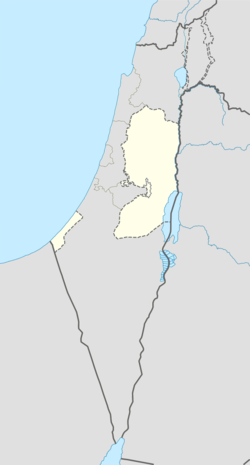Baqa ash-Sharqiyya
| Baqa ash-Sharqiyya | |
|---|---|
| Other transcription(s) | |
| • Arabic | باقه الشرقية |
| • Also spelled | Baqa al-Sharqiyya (official) Baqa ash-Sharkiya (unofficial) |
| Location of Baqa ash-Sharqiyya within the Palestinian territories | |
| Coordinates: 32°24′38″N 35°04′09″E / 32.41056°N 35.06917°ECoordinates: 32°24′38″N 35°04′09″E / 32.41056°N 35.06917°E | |
| Palestine grid | 156/201 |
| Governorate | Tulkarm |
| Government | |
| • Type | Municipality |
| • Head of Municipality | Muaiad Abd al-Rahman Hussein |
| Area | |
| • Jurisdiction | 4,211 dunams (4.2 km2 or 1.6 sq mi) |
| Population (2007) | |
| • Jurisdiction | 4,101 |
| Name meaning | "The eastern bouquet [of flowers]" or "The eastern Baka" |
Baqa ash-Sharqiyya (Arabic: باقه الشرقية) is a Palestinian town in the northern West Bank, located 16 kilometers (9.9 mi) northeast of Tulkarm in the Tulkarm Governorate. According to the Palestinian Central Bureau of Statistics (PCBS), the town had a population of 4,101 inhabitants in 2007.Refugees made up 20.4% of the Baqa ash-Sharqiyya's population in 1997.
Approximately 3 kilometers (1.9 mi) to the west, on the other side of the Green Line, lies Baqa al-Gharbiyye, ("the western bouquet of flowers") which is under Israeli jurisdiction. Both towns were originally one town, known as Baqa, until the aftermath of the 1948 Arab-Israeli War. Prior to the Second Intifada, Baqa ash-Sharqiyya consisted of 4,000 dunams; Israel confiscated about 2,000 dunams of land in order to build the Israeli West Bank barrier.
Baqa ash-Sharqiyya is situated at an ancient site. During early Ottoman rule, in 1596, Baqa ash-Sharqiyya was located in the nahiya of Qaqun in the Sanjak of Nablus. It had a population of 35 households, and paid taxes on wheat, barley, summer crops, olives, goats and/or bees, and a press for olives or grapes.
In 1882 the Palestine Exploration Fund's Survey of Western Palestine described Baqa as "a very small hamlet on high ground, with olives. It has a well to the south and a little Mukam (Muslim tomb) to the north; scattered olives surround it, and there are two or three palms close by. A few houses stand separate, on the south east, near a second Mukam, called Abu Nar ("Father of Fire")." A stone with Arabic inscriptions located over the entrance of the old village mosque could be the beginning of an endowment (waqf) text.
...
Wikipedia

